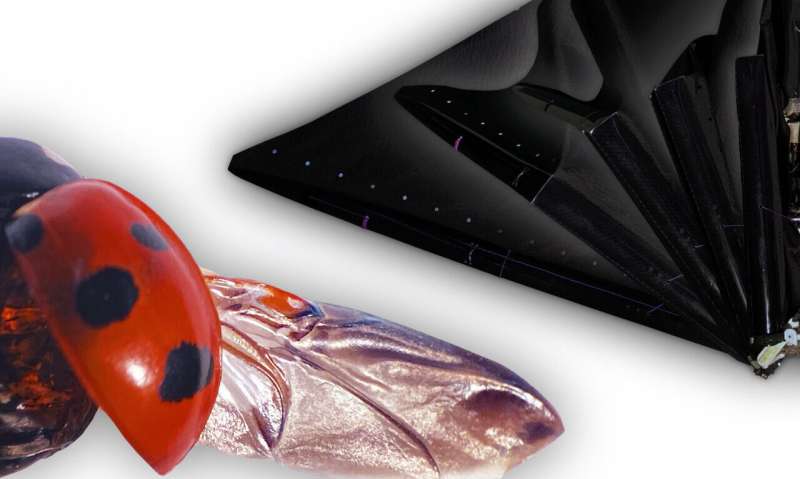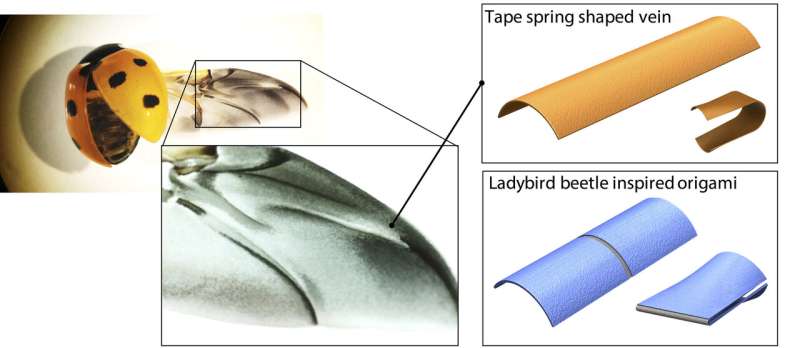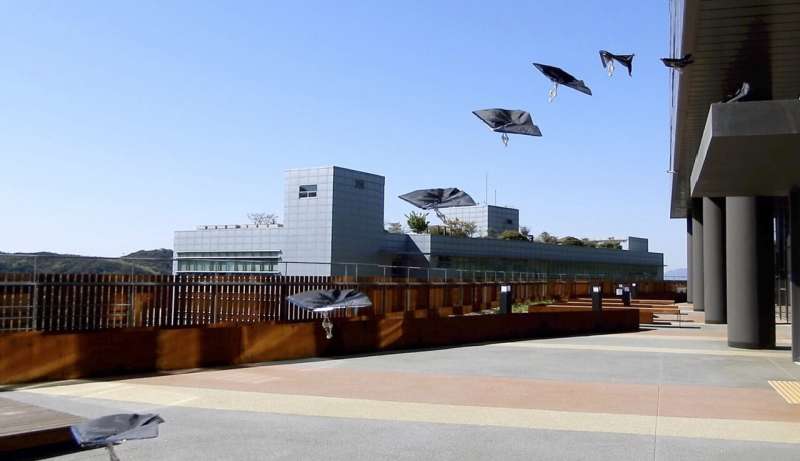June 3, 2020 feature
An origami-based robotic structure inspired by ladybird wings

Researchers at Seoul National University have recently developed a compact and lightweight origami structure inspired by ladybird beetles. In a paper published in Science Robotics they show how this structure can be used to build a winged jump-gliding robot. Jump-gliding is a specific locomotion style that combines gliding and jumping movements.
"Our goal was to develop a wing for a jump-gliding robot," Kyu-Jin Cho, director of soft robot research center and lead researcher for the study, told TechXplore. "Jump-gliding locomotion can increase the energy efficiency and travel distance of the robot. To do this, the wings should be foldable, rapidly deployable and resilient under aerodynamic forces."
In past studies, most researchers developing jump-gliding robots adopted design strategies that entail the addition of linkages, springs and actuators to the robots' wings. These techniques, however, tend to make robots particularly heavy and bulky, hindering their overall locomotion performance.
Cho and his colleagues set out to develop a design strategy for jump-gliding robots that draws inspiration from nature, more specifically from ladybird beetles. Ladybirds can rapidly deploy their intricately folded wings within 0.1 seconds; a time shorter than the blink of an eye.
Moreover, a ladybird's wings are known to be highly resistant and sturdy, which prevents them from folding or buckling when flapping at a high frequency. Cho and his colleagues wanted to create an artificial structure with qualities resembling those of ladybird wings, which could be deployed as a wing both quickly and efficiently.
"We developed a novel origami structure that is rapidly self-deployable and resilient under large forces," Sang-Min Baek, the first author of the study, explained. "We then applied this novel origami structure to the wing frame of the deployable wing module. Based on this deployable wing module, we were able to build a jump-gliding robot with a lightweight, foldable but sturdy wing."
The reason that ladybird wings are both easily deployable and resistant is that they are built around a uniquely shaped tape spring-like vein. When a ladybird beetle folds its wings, this tape spring-shaped vein deforms, allowing elastic energy to be stored inside it. This stored energy is what ultimately allows the wings to be quickly and easily deployable.

"Due to the cross-sectional curvature of the tape-spring-shaped vein, the wings are also sturdy under large aerodynamic forces, just like a tape measure sustains its straightened shape," Baek explained. "We applied its geometry and compliance to the facets of the origami structure. Therefore, the origami structure acquires energy storage and self-locking capability without any additional component."
Traditionally, origami structures are made up of flat and rigid facets, with highly flexible fold lines. In robotics applications, however, these conventional structures tend to present limitations in terms of energy storage and locking abilities. Cho and his colleagues thus decided to employ a different origami approach that entails the integration of curved geometries into facets, essentially treating each facet as a deformable element.

"Using this approach, the origami structure acquires both energy storing and locking abilities without any additional components," Cho said. "Furthermore, this origami design method can be easily applied to the conventional origami structure fabrication process. Therefore, our origami design method, which we call compliant origami, can be easily applied to a wide variety of deployable systems."
So far, Cho and his colleagues applied and tested their origami-based structure on a single jump-gliding robot, but in the future, it could be used to create several other robots. Moreover, their study focused more on the origami structure itself than on the resulting robot. In their next studies, the researchers thus plan to investigate the performance and capabilities of the jump-gliding robot they built using their origami structure.

"The multi-modal robot we developed can overcome various rough terrains by combining capabilities such as jumping, crawling, gliding, flapping and perching," Cho said. "Nature uses combinations of functionalities to produce these movements, but current robots are focused on a single functionality. By developing new components that are suitable for combining multiple functionalities, future robots could have multi-modal capabilities without the need to increase the complexity or weight of a robot."
More information: Sang-Min Baek et al. Ladybird beetle–inspired compliant origami, Science Robotics (2020). DOI: 10.1126/scirobotics.aaz6262
© 2020 Science X Network




















